
HOME
INTRO
SYMBOLS
ALMANAC
ECONOMY
GEOGRAPHY
STATE MAPS
PEOPLE
FORUM
NEWS
COOL SCHOOLS
STATE QUIZ
STATE LINKS
BOOK STORE
MARKETPLACE
NETSTATE.STORE
NETSTATE.MALL
GUESTBOOK
CONTACT US


South Carolina State Shell
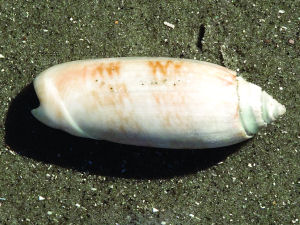
South Carolina State Shell: Lettered Olive (Oliva sayana)
Credit: ©The Southeastern Regional Taxonomic Center
South Carolina Department of Natural Resources
Used with permission.
On May 8, 1984, Governor Richard Riley signed Senate Bill No. 735 (S735) declaring, the peach South Carolina's official fruit, milk the official beverage, and the lettered olive the state's official shell.
Act No. 360 below, created by S735, lists the reasons that the General Assembly chose the lettered olive as the official shell of South Carolina.
- South Carolina's Atlantic coast, where lettered olives may be found, is widely promoted as a tourist and recreation destination.
- Shell collecting along South Carolina beaches is increasingly popular among a wide spectrum of the tourist and resident population.
- Lettered olives are quite common along the South Carolina coast.
- The lettered olive was identified and named by a South Carolinian, Dr. Edmund Ravenel of Charleston. Dr. Ravenel was an early pioneer in conchology.
(A360, R410, S735)
AN ACT
TO AMEND THE CODE OF LAWS OF SOUTH CAROLINA, 1976, BY ADDING SECTIONS 1-1-680, 1-1-690, AND 1-1-695, SO AS TO PROMOTE THE AGRICULTURAL INDUSTRY OF SOUTH CAROLINA BY DESIGNATING THE PEACH AS THE OFFICIAL FRUIT OF THE STATE, MILK AS THE OFFICIAL STATE BEVERAGE, AND THE LETTERED OLIVE AS THE OFFICIAL STATE SEASHELL.
Be it enacted by the General Assembly of the State of South Carolina:
Findings
SECTION 1. The General Assembly finds that:
(1) South Carolina is the nation's leading peach producer and shipper east of the Mississippi River producing, in 1981, the largest crop ever - over four hundred thirty million pounds, worth over sixty-two million dollars;
(2) Statistically reported as "the Nation's Fresh Peach State in Interstate Shipments", South Carolina in 1981 packed and shipped three hundred ninety-three million pounds of peaches;
(3) Several large in-state markets have enabled South Carolina to earn the distinction of shipping more peaches out of state than any other state;
(4) Peach production forecasts indicate that by 1985 South Carolina will produce more fresh peaches than any other state in the nation, which will give a tremendous boost to the state's economy.
Peach declared official fruit
SECTION 2. The 1976 Code is amended by adding:
"Section 1-1-680. The peach is the official fruit of the State."
Findings
SECTION 3. The General Assembly finds that:
(1) The use of milk and milk products is the best way to provide a healthy but varied diet;
(2) Over twenty percent of the nation's protein is supplied by dairy products;
(3) Seventy-two percent of all the nation's calcium comes from dairy products;
(4) Dairy farmers are found in every county of this State except seven;
(5) Nearly fifty thousand cows produce nearly five hundred seventy million pounds of milk annually in the State with a gross volume alone of over eighty-nine million sixty-two thousand dollars;
(6) The dairy industry in this State represents a one hundred million dollar enterprise.
Milk declared official beverage
SECTION 4. The 1976 Code is amended by adding:
"Section 1-1-690. Milk is the official state beverage."
Findings
SECTION 5. The General Assembly finds that:
(1) South Carolina's coastal area is one of the most widely promoted areas in the State for recreation and tourism.
(2) Shelling along the beaches of South Carolina is becoming increasingly popular among residents as well as with the tourist trade. It is a form of recreation which can be enjoyed by a wide spectrum of the population.
(3) The Lettered Olive shell is quite prolific along the South Carolina coast and will make the finding of the shell more meaningful for South Carolinians, tourists, and shell collectors.
(4) The Lettered Olive was found and named by a South Carolinian, Dr. Edmund Ravenel of Charleston, who was an early pioneer in conchology. This name was given to this shell because of its hieroglyphic type markings.
Lettered olive declared official shell
SECTION 6. The 1976 Code is amended by adding:
"Section 1-1-695. The Lettered Olive, Oliva sayana, is the official shell of the State."
Time effective
SECTION 7. This act shall take effect upon approval by the Governor.
Picky, picky, picky...
Perhaps we're being too picky, but we think this designation is flawed. Here's why.
Oliva sayana is a large sea snail that lives along the south eastern Atlantic coast of the United States, along the states on the Gulf of Mexico and the coast of Mexico. A sea snail carries a shell with it.
We know that the various species of sea snails can be differentiated by the shapes of their shells.
South Carolina has designated the lettered olive their official state shell, but shouldn't they have more precisely designated the shell of the lettered olive their official state shell?
Most of the states that have designated official shells, like South Carolina, have not made the distinction but the most recent members of the official state shell club, New Jersey and Delaware, have passed legislation that carefully stipulates that it is the "shell of..." that they are recognizing, not the animal itself.
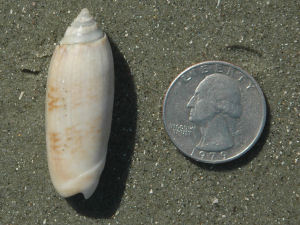
South Carolina State Shell: Lettered Olive (Oliva sayana)
Credit: ©The Southeastern Regional Taxonomic Center
South Carolina Department of Natural Resources
Used with permission.
South Carolina Law
The following information was excerpted from the The South Carolina Code of Laws, title 1, chapter 1, article 9, section 1-1-695.
Title 1 - Administration of the Government
CHAPTER 1. GENERAL PROVISIONS
ARTICLE 9. STATE EMBLEMS, PLEDGE TO STATE FLAG, OFFICIAL OBSERVANCES
SECTION 1-1-695.
SECTION 1-1-695. Official State shell.
The Lettered Olive, Oliva sayana, is the official shell of the State.
Sources...
State of South Carolina. South Carolina Code of Laws. Columbia: State of South Carolina, 2011. Web. 6 Jun 2011.
Shearer, Benjamin F. and Barbara S. State Names, Seals, Flags and Symbols: A Historical Guide Third Edition, Revised and Expanded. Westport, Conn: Greenwood Press, 3 Sub edition, 2001.
Additional Information
Lettered Olive Shell: Scribblings on the Surface: Short article by Patricia B. Mitchell at Mitchell Publications.
Oliva sayana (lettered olive): The University of Michigan Museum of Zoology: Animal Diversity Web.
Oliva sayana (Ravenel, 1834): Integrated Taxonomic Information System (ITIS) Here you will find authoritative taxonomic information on plants, animals, fungi, and microbes of North America and the world.
Lettered olive images: Lettered olive images provided by Google search.
State shells: Complete list of official state shells from NETSTATE.COM.
More symbols & emblems: Complete list of official South Carolina state symbols from NETSTATE.COM.

Seashells of Georgia
and the Carolinas
Seashells of Georgia and the Carolinas, by Blair and Dawn Witherington. 84 pages. Publisher: Pineapple Press (May 31, 2011) This book displays the diversity of seashells that can be found along the 600 miles of Atlantic beaches in Georgia and North and South Carolina. They are pictured in the way they come to us on beaches. Knowing the names, stories, and varied appearances of seashells can sharpen a beachcomber’s eyes to their beauty and rarity. This guide includes species common to the southeastern United States.
Descriptive accounts, maps, and color photos describe 100 species of mollusk shells as beachcombers are likely to find them.
Includes glimpses of each seashell’s former life and secrets for finding seashell treasures that many beach visitors miss.

Smithsonian Handbooks
Shells
S. Peter Dance
Smithsonian Handbooks: Shells, by S. Peter Dance. 256 pages. Publisher: Dorling Kindersley (May 15, 2002) Authoritative text, crystal-clear photography, and a systematic approach make DK's Smithsonian Handbook of Shells the most comprehensive and concise pocket guide to seashells of the world. Packed with over 600 full-color photographs of over 500 species of seashells, this handy reference book is designed to cut through the complex process of identification.
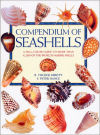
Compendium
of Seashells
Compendium of Seashells, by R. Tucker Abbott and S. Peter Dance. 411 pages. Odyssey Publications; 4 edition (July 2000) A full-color guide to more than 4,200 of the world's marine shells. This comprehensive, full-color identification book on marine shells of the world is a must for serious shell-collectors and hobbyists. Combined by two of the world's leading malacologists, this beautiful and authoritative reference volume includes 4,200 full-color photographs to make shell identification quick and easy. All categories of marine shells are described and illustrated, including individual photographs, geographical and ecological information on hundreds of species of cowry, cone, valute, scallop, helmet and many others. Compendium of Seashells is designed to facilitate rapid location and identification of almost every shell likely to be found in a private collection or shell shop.
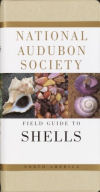
Field Guide to North
American Seashells
National Audubon Society Field Guide to North American Seashells, Revision authors are James D. Williams, Research Associate, Florida Museum of Natural History, and Carter R. Gilbert, Curator Emeritus of Fishes of the Florida Museum of Natural History. 896 pages. Publisher: Knopf (August 12, 1981) The essential book for beach-combers and divers, this guide explores more than 705 seashells, living mollusks, abalone, periwinkles, conchs, limpets, oysters, clams, mussels, and cockles found on the Atlantic, Pacific, and Gulf coasts of North America and the West Indies. The photographs are arranged by shape and color, making identification quick and easy.
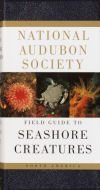
Field Guide to North
American Seashore Creatures
Norman A. Meinkoth
National Audubon Society Field Guide to North American Seashore Creatures, by Norman A. Meinkoth. 816 pages. Publisher: Chanticleer Press ed edition (December 12, 1981) Each of the 690 identification pictures is a full-color photograph of a seashore creature. Arrangement by shape and by color makes identification quick and easy. 666 species are covered in full detail.

